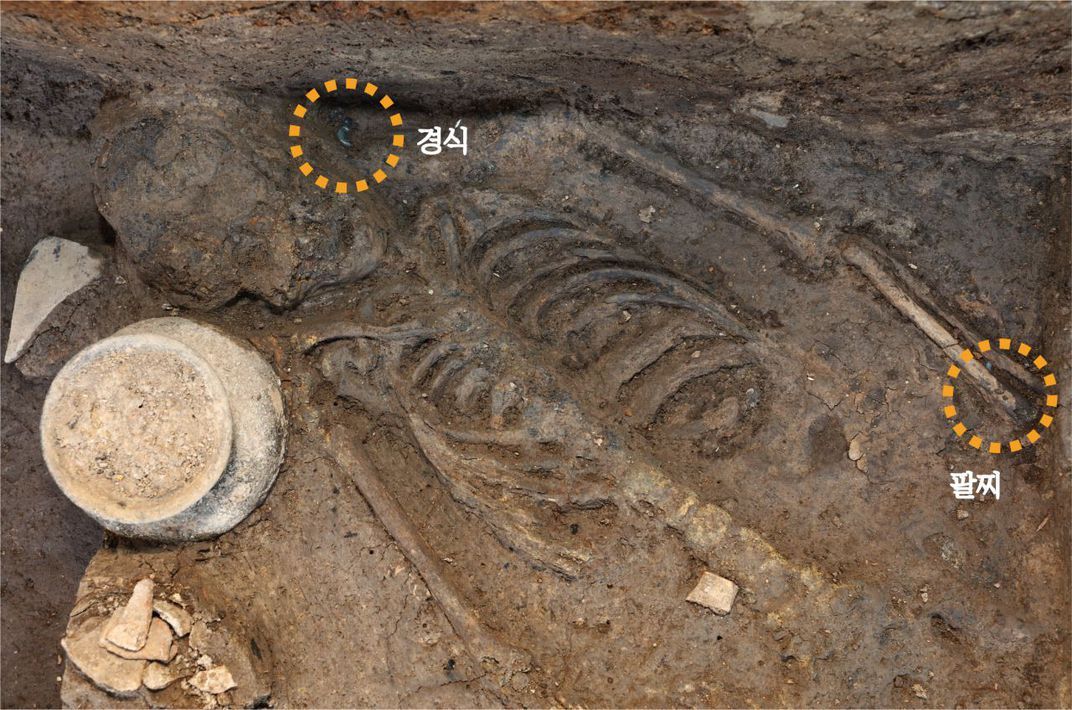Remains of Likely Human Sacrifice Victim Found in Foundation of Korean Palace
The young woman died in her 20s during the fourth century C.E.
:focal(750x464:751x465)/https://tf-cmsv2-smithsonianmag-media.s3.amazonaws.com/filer_public/93/11/93111062-7447-42b1-82dc-9357de497c11/smartnewswolseong_palace.png)
Archaeologists in Gyeongju, South Korea, have unearthed the remains of a woman who was probably sacrificed during construction of the Wolseong palace fortress in the fourth century C.E.
This is the second such discovery at the complex, where two other bodies were found in 2017, reports Park Ji-won for the Korea Times.
“The three bodies are buried in the section built [prior] to the main wall of the rampart,” said Jang Gi-myung, a researcher at the Gyeongju National Research Institute of Cultural Heritage (GNRICH), during an online press conference held last week, per the Korea Times. “Based on the fact that they are located near the main entrance … along with the selected bones of animals as if protecting the wall, we [can] assume that they were buried as part of a ritual for the safe construction of the architecture.”
As Korea JoongAng Daily’s Yim Seung-Hye reports, the 2017 discovery offered the first physical evidence of the country’s Silla people practicing human sacrifice. Until then, contemporary observers had viewed stories of such killings—carried out to ensure construction projects’ long-term success—as myths.
The bodies found in 2017 belonged to a man and a woman in their 50s. The newly discovered remains belong to a woman in her 20s. According to the researchers, all three appear to be of a low-ranking class, as their teeth show signs of nutritional deficiencies and they are undersized, with the young woman standing only about 4 feet 5 inches tall. None of the bodies show signs of a struggle.
Song Seung-hyun of the Korea Herald writes that researchers initially thought the woman was a girl because of her short stature. But they later discovered that her growth plates were closed.
The young woman was buried with ornaments including bracelets and a necklace made of comma-shaped gogok glass beads, per Hankyoreh’s Roh Hyung-suk. Animal bones found near the human remains appear to have come from large mammals. An earthen vase also discovered near the woman’s bones may have been used for drinking during the sacrificial ritual. Archaeologists found pottery remains near the bones discovered in 2017, too.

The Wolseong palace was the seat of the Silla dynasty, which led one of three ancient Korean kingdoms. Traditional histories suggest Silla was founded in 57 B.C.E. and became a hereditary monarchy in the fourth century C.E. Later, in the seventh century, Silla allied with China’s T’ang dynasty and defeated its rival kingdoms to establish a unified Korean kingdom. Silla authorities supported the flourishing of Buddhism, which arrived in Gyeongju around the fifth century.
Excavation of the palace site, which covers about 50 acres, began in 2014. Researchers found that work on the fortress began in the early to mid-fourth century and ended in the early fifth century. Workers built the walls in four stages, with burials of the human sacrifices conducted after the land was leveled but before construction began.
When researchers discovered the first set of remains, some questioned whether the pair’s deaths could have been accidental—but the bodies’ condition and the animal bones found nearby suggested otherwise.
“Now with the additional discovery, there’s no denying Silla’s practice of human sacrifice,” Choi Byung-heon, an archaeologist at Soongsil University, tells Korea JoongAng Daily. “… After finishing off the foundation and moving onto the next step of building the fortress, I guess it was necessary to really harden the ground for the fortress to stand strong. In that process, … the Silla people held sacrificial rites, giving not only animals but also humans as sacrifices.”
Stories about human sacrifices during construction are common in many places around the world, including Great Britain, India and Japan, wrote Amelia Soth for JSTOR Daily in 2018. But archaeological evidence of the practice is often ambiguous. In many cases, it’s unclear whether people whose bodies are found beneath buildings died as a result of accidents, murders or ritual sacrifices.
The recent excavation also offered researchers more information about the fortress’ construction.
“We’ve discovered the method of building Wolseong, which mainly used soil,” Ahn So-yeon, a researcher from GNRICH, tells Korea JoongAng Daily. “We’ve discovered how Silla people mixed stones, pieces of wood, seeds of fruits and grains with soil to make the fortress stronger.”
/https://tf-cmsv2-smithsonianmag-media.s3.amazonaws.com/accounts/headshot/Livia_lg_thumbnail.png)
/https://tf-cmsv2-smithsonianmag-media.s3.amazonaws.com/accounts/headshot/Livia_lg_thumbnail.png)